The soft touch of the west wind, carrying the scent of the evening flowers, is a delightful experience that I cherish every spring. In Greek Mythology, this West wind was personified through Zephyrus, son of Eos and Astraeus. Out of the Anemoi, Zephyrus was the most favorable and gentle of the winds, akin to a gentle breeze. Let’s learn more about this gentle wind and the cult surrounding him.
Zephyrus Key Facts
| Parents | Eos and Astraeus |
| Partners | Chloris |
| Siblings | Boreas, Notus, Eurus |
| Offspring | Karpos |
| Other names | Zephyros |
| Roman name | Favonius |
| The God of | The West Wind |
| Symbols | Flowers |
Name and Etymology
The name Zephyrus has roots in the ancient Greek word “Zephyros,” which translates to the west wind. This etymology is straightforward, yet it carries a poetic essence, embodying the gentle breeze that Zephyrus represents. In Roman mythology, he is known as Favonius, a name that also echoes the soft and favorable winds of spring.
The epithets and other names for Zephyrus are fewer compared to other deities, perhaps due to his less tumultuous nature. However, each name he holds is a reflection of his gentle demeanor and the soothing, life-giving breeze he brings. His Roman counterpart, Favonius, shares a similar essence, embodying the mild and nurturing aspect of the west wind.
The transition from the harsh cold winds of winter, represented by his brother Boreas, to the soft caress of Zephyrus, is a beautiful depiction of the changing seasons. The name Zephyrus itself has become synonymous with the hopeful, renewing breeze of spring. It is a subtle yet powerful force of nature that holds a special place in Greek mythology.
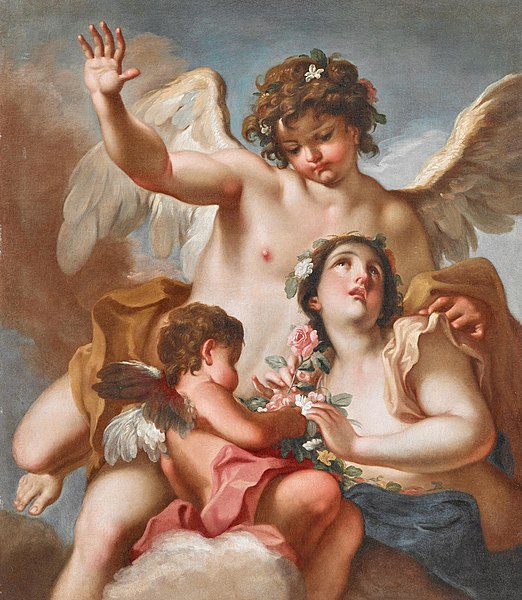
Zephyrus Origins
The lineage of Zephyrus traces back to the early dawn, quite literally. He is the son of Eos, the goddess of dawn, and Astraeus, the god of dusk. This union of dawn and dusk symbolizes the eternal cycle of day and night. Together with the always changing winds, including Zephyrus, embodying the natural forces that govern the world.
There isn’t a detailed narrative surrounding the birth or childhood of Zephyrus. This is moreover a common trait among the personifications of natural phenomena in Greek mythology. However, his emergence as a gentle wind is a poetic illustration of the softer side of nature. Standing as a soothing respite from the harsh cold brought by his brother Boreas.
Zephyrus, as a Daemones (Spirit) in Greek myth, holds a tender yet significant role. His west wind not only signals the arrival of spring but also nurtures the land, preparing it for the bounties of summer. This personification enriches the Greek mythos, adding a layer of depth to the understanding of natural cycles and their impact on human life.
Zephyrus Family
The love story between Zephyrus and Chloris is a tale as tender as the spring breeze he represents.
Chloris
Chloris, the goddess of flowers, caught the eye of Zephyrus, and their union is a beautiful depiction of spring’s essence. The west wind, with its gentle touch, nurtures the blossoms, which in turn, adorn the earth with a riot of colors. The love between Zephyrus and Chloris is often seen as a metaphor for the harmonious relationship between the wind and flowers, a delicate balance that heralds the arrival of spring.

Karpos
The son of Zephyrus and Chloris, Karpos, embodies the fruitfulness of spring. His name, which translates to fruit, is a direct representation of the bounties that the season of spring brings forth. The lineage continues the theme of renewal and growth, portraying a cycle of life that is both poetic and profound.
The divine lineage of Zephyrus, through his union with Chloris and the birth of Karpos, paints a beautiful picture of continuity and the eternal cycle of nature.
Depiction And Characteristics
The depiction of Zephyrus, like his siblings, varies between a youthful male figure and a horse, embodying the essence of the wind he represents.
Zephyrus Appearance
The imagery surrounding Zephyrus is as gentle and soothing as the west wind he personifies. When depicted as a young man, he is often shown with a light, flowing cloak that symbolizes the gentle breeze of spring. His presence in art and sculpture carries a sense of calm and serenity, a stark contrast to the fierce and cold imagery associated with his brother Boreas. In some instances, he is shown with wings, a literal representation of his airy domain.
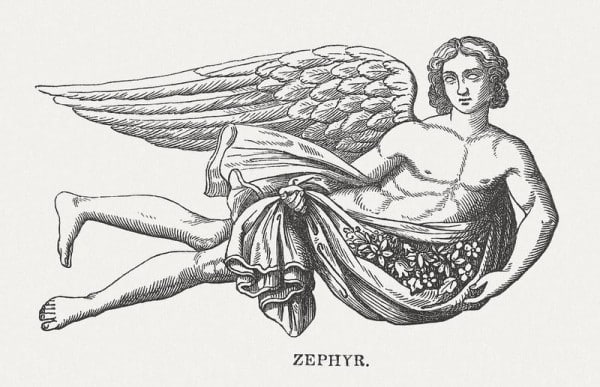
On the other hand, when depicted as a horse, the imagery captures the swift and free-spirited nature of the wind. The horse, a symbol of grace and agility, embodies the gentle yet swift characteristics of the west wind that Zephyrus represents. This equine depiction is a powerful visual representation of the natural forces he embodies.
The symbols associated with Zephyrus are often those of spring. Flowers, particularly roses, are commonly seen with him, representing the blossoming and renewal that his wind brings to the land. These symbols are not just decorative, but carry a deeper meaning, embodying the hope and rejuvenation that spring heralds.
Zephyrus Roles And Responsibilities
The roles and responsibilities of Zephyrus extend beyond just the physical manifestation of the west wind. His gentle breeze is a harbinger of spring, a season of renewal and growth. This role is crucial in the cyclical nature of life, marking the transition from the death of winter to the rebirth of spring.
His responsibility also lies in nurturing the land, preparing it for the bounties of summer. The gentle touch of his wind, coupled with the blossoming flowers, creates the ideal conditions for growth. This nurturing aspect of Zephyrus’ role is a poetic reminder of the delicate balance that sustains life.
The depiction of Zephyrus as a nurturing force also reflects the ancient Greeks’ understanding and appreciation of the natural cycles. His role as the harbinger of spring is not just a poetic notion, but a reflection of the ancient Greeks’ attunement to the rhythms of nature and their reverence for the forces that govern these cycles.
Myths about Zephyrus
The myths surrounding Zephyrus often highlight his gentle and nurturing nature, but also showcase moments of jealousy and rivalry, adding a layer of complexity to his character.
The Love Story with Chloris
One of the most endearing myths is his love story with Chloris, the goddess of flowers. This tale is a beautiful depiction of the symbiotic relationship between the wind and flowers, a poetic representation of the essence of spring. The gentle caress of Zephyrus’ wind nurtures the blossoms, which in turn, adorn the earth with a riot of colors.
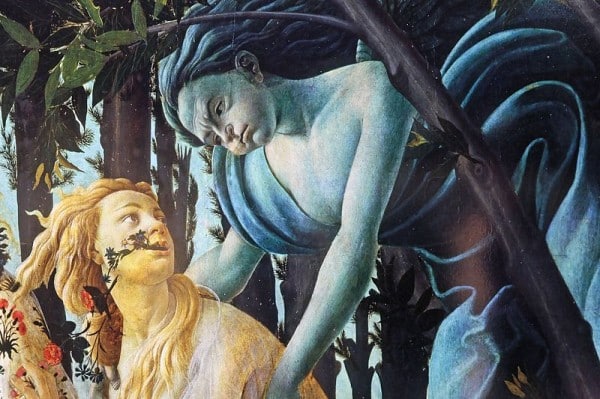
The love between Zephyrus and Chloris is not just a romantic tale, but a metaphor for the harmonious relationship between the elements of nature. It’s a gentle reminder of the delicate balance that sustains life, a balance that is often taken for granted.
The Abduction of Hyacinth
Another myth that stands out is the tragic tale of Hyacinth, a beautiful youth loved by both Zephyrus and Apollo. The rivalry between the two gods leads to a tragic accident that results in the death of Hyacinth. Apollo and Hyacinth were enjoying a game of discus, when Apollo, in an attempt to impress Hyacinth, threw the discus with great strength. Jealous of their camaraderie and filled with envy, Zephyrus intervened with a gust of wind, causing the discus to veer off course and strike Hyacinth in the head, leading to his tragic demise.
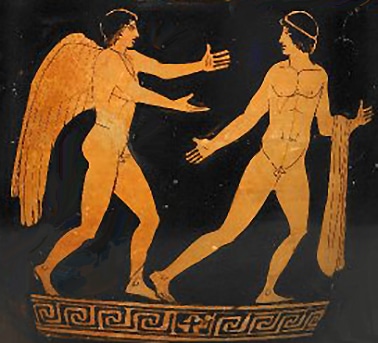
The myth of Hyacinth highlights a rare moment of jealousy and rivalry in Zephyrus’ otherwise gentle demeanor. It’s a poignant reminder of the complex emotions that even the gentlest of beings can harbor. Furthermore adding a layer of depth to Zephyrus’ character. The tragic tale also reflects the transient nature of beauty and the inevitable passage of time, themes that resonate deeply within the human experience.
Zephyrus In Ancient Greek Religion
The reverence for Zephyrus in ancient Greek religion reflects the importance of the natural cycles he represents.
Sites or Temples Sacred to Zephyrus
The Tower of the Winds in Athens, although not a place of worship, is a notable site that honors all the wind gods. This ancient structure is believed to have been a meteorological station, possibly the worlds oldest. Moreover, it stands as a great example of how the ancients mixed religious belief and budding scientific understanding. The Greeks integrated their reverence for wind deities like Zephyrus with their early explorations into meteorology. This blend of belief and science reflects the holistic approach of the ancient Greeks towards understanding the natural world.
In the realm of more traditional religious reverence, there are mentions of cults and altars dedicated to Zephyrus across different regions. For instance, in the epic “Argonautica” by Valerius Flaccus, the Argonauts pay reverence to Zephyrus for a favorable sailing wind alongside Poseidon and Glaucus. This act of reverence showcases the importance of Zephyrus in the lives of those who relied on the natural forces he represented.
In Rhodes, an island in the Aegean, Eudemus dedicated a temple on his land to Zephyrus. This is mentioned in the epigrams by Bacchylides. This dedication came as a response to Zephyrus aiding Eudemus in winnowing grain swiftly, showcasing a direct and beneficial interaction between humans and the deity.
Furthermore, in Laciadae, a town in Attica, an altar dedicated to Zephyrus is mentioned in Pausanias’ “Description of Greece.” These mentions across different texts and regions highlight the scattered yet significant reverence for Zephyrus in ancient Greek religion.
Worship and Festivals
The worship of Zephyrus, like that of other wind gods, was often intertwined with the reverence for the natural cycles. While there aren’t specific festivals dedicated to Zephyrus, the arrival of spring was a cause for celebration, a time to honor the gentle breeze that nurtured the land.
The ancient Greeks, recognized the importance of each season and the wind gods who governed them. The subtle yet profound influence of Zephyrus’ west wind was a part of this reverence. A divine acknowledgment of the delicate balance that sustains life.
Representations Of Zephyrus In Art
The representation of Zephyrus in art is as gentle and soothing as his nature. His imagery often depicts a handsome young man, surrounded by flowers, embodying the essence of spring. The soft, flowing lines used to depict Zephyrus reflect the gentle caress of his wind. A visual representation of his nurturing demeanor.
The portrayal of Zephyrus in art is not just a visual delight, but a poetic representation of his essence. The gentle lines, the soft colors, and the serene expressions all embody the hope and renewal that Zephyrus represents.
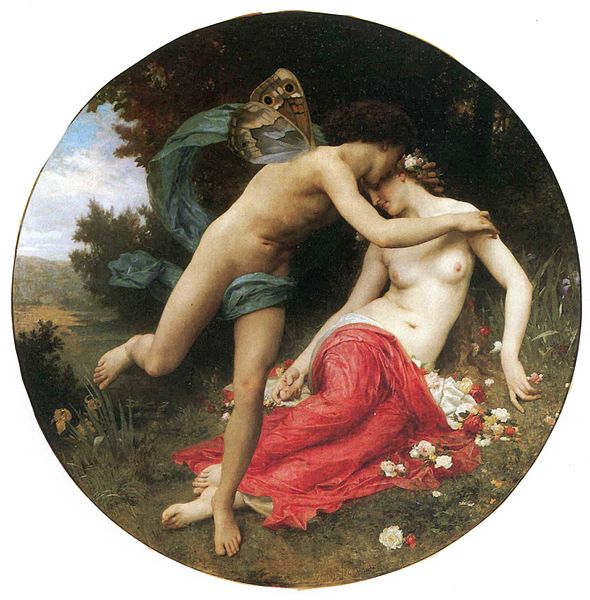
Mentions in Ancient Texts
Mentions of Zephyrus in ancient texts are often poetic, reflecting his gentle nature and the soothing essence of his wind. Various authors from different periods have referenced Zephyrus, showcasing the enduring significance of this deity in Greek culture and mythology.
Hesiod’s “Theogony” (circa 700 BC)
Hesiod, a Greek poet traditionally dated around 700 BC, is often considered as one of the earliest Greek poets. His work “Theogony” is a foundational piece of Greek mythology, offering genealogies of the gods. In this work, Hesiod mentions Zephyrus as one of the Anemoi, born to Eos and Astraeus.
Homer’s “Odyssey” (circa 8th century BC)
Homer, the legendary author of the “Iliad” and the “Odyssey,” mentions Zephyrus in the “Odyssey.” In this epic, Zephyrus is invoked for a safe and smooth journey. A testament to the favorable winds of Zephyrus sought by sailors, a reflecting his gentle and supportive nature.
Valerius Flaccus’ “Argonautica” (1st century AD)
Valerius Flaccus, a Roman poet who lived in the 1st century AD, wrote “Argonautica,” an epic poem that recounts the adventures of Jason and the Argonauts. In this work, the Argonauts pay reverence to Zephyrus for a favorable sailing wind alongside Poseidon and Glaucus. This act of reverence showcases the importance of Zephyrus in the lives of those who relied on the natural forces he represented.
“[The Argonauts prepare to depart on their voyage :] Next in joy they pile altars; chiefly unto thee, lord of the waters [Poseidon], is reverence paid, unto thee, unto Zephyros (the West Wind) [for a favourable sailing wind] and unto Glaucus upon the shore Ancaeus sacrifices an ox decked with dark blue fillets, unto Thetis a heifer.”
Frequently Asked Questions
Zephyrus represents the west wind, often associated with the gentle breeze of spring that heralds the arrival of warmer days. His gentle nature nurtures the land, preparing it for the bounties of summer.
Zephyrus is one of the Anemoi, the wind gods. His siblings include Boreas (the north wind), Notus (the south wind), and Eurus (the east wind).
Zephyrus is often depicted as a handsome young man, surrounded by flowers,. Furthermore embodying the gentle and nurturing essence of the west wind.
There aren’t many specific temples dedicated to Zephyrus. However his presence is often acknowledged in the broader worship of the Anemoi, particularly in the Tower of the Winds.
Featured Image Credit: The Pisticci Painter, Public domain, via Wikimedia Commons
